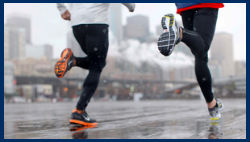How to Run in the Rain
 “It’s supposed to rain… what should I wear?”
“It’s supposed to rain… what should I wear?”
We get it all the time. The rain question. How should you dress if it’s supposed to pour on race day? Storm during a long run? Drizzle on a daily dash?
In addition to being a primo opportunity to use the phrase, “It’s a real gullywasher!” (c’mon, who doesn’t love saying that?), running in the rain can be one of the most fun, liberating, devil-may-care training experiences. It can also be miserable. (We call these “character-building” runs.) At the very least, rain is a recreational hazard that must be endured. You have to train in the rain because, chances are, one of these days you’ll have to race in the rain. And the miles don’t care if you get wet.
But there is a method to the meteorological madness. We’ve listed some of our top rainy day guidelines to help you not just beat the elements, but (dare we say it?) enjoy them. Here’s to the rain!
Head first. No matter the temperature, season, distance, or pace, a hat with a brim is your number one rain run accessory. The brim will keep the rain off your face and out of your eyes so you can see. (Always a plus.) Make sure the hat is moisture-wicking and running-specific. It should keep you cool and stay snug even on windy days.
Temperature matters. At 60 degrees and above, rain is a refreshing break from the heat. But once the temperatures drop into the 50s and 40s, rain can make you uncomfortably cold—and miserable. Layers will keep you dry and warm, but only if they are the right layers. Inside layers should be technical and moisture-wicking. Outside layers should be weather resistant. Which leads us to our next tip…
Layer strategically. Make sure the layer closest to your body is technical, fitted, and moisture-wicking. Your outer layer should be wind- and water-resistant. A lightweight weather-resistant running jacket works in moderate temperatures, while chill-you-to-the-bone winter rains may require a heavier version. But while it is key to stay warm, make sure that you…
Don’t overdress. It’s the most common mistake runners make in rainy weather. You’ve heard it said that you should dress as though it were 15-20 degrees warmer than it actually is. This truth applies even in the rain, though you may need to narrow the temperature margin the colder it gets. (Sunny and 40 degrees will feel warmer than rainy and 40.)
Be visible during the day. Clouds, rain, fog, mist, and a hopelessly gray landscape mean reduced visibility for drivers. Now is the time to grab your reflective gear and blinking lights—during the day. If cars can see you, they’ll be less likely to hit you. (Another plus.)
Don’t chafe. Wet weather increases the potential for chafing. Use Body Glide even on shorter runs, paying attention to areas where friction is especially noticeable, such as your feet, inner thighs, underarms, and bra lines. Guys should use sweatproof nipple guards, such as Nip Guards. (Old school band-aids fall off in the rain.)
Don’t wear “Brett Favre” shoes. You know, the ones you keep pulling out of retirement when it rains? We know it’s tempting to keep an old pair of broken down shoes for inclement weather (thereby saving those barely worn beauties you bought two weeks ago), but don’t do it. Shin splints, Achilles tendonitis, knee pain, and other injuries can’t discriminate between weather patterns. If you’ve got several pairs of shoes still in your running rotation, by all means wear the pair with the most miles. But remember: If the shoes aren’t good enough to wear when it’s dry, don’t wear them when it rains.
Fill your shoes with news. After you’re finished running, stuff newspaper into your shoes. (No, seriously.) The newspaper will help the shoes keep their shape and draw out moisture. You may have to switch out the newspapers once or twice depending on how wet your shoes are (or how fast they can read).
Keep your electronics Ziploc fresh. To prevent an unfortunate malfunction, buy a waterproof holder for your smart phone, iPod, and other electronic devices. If your holder isn’t waterproof, plop the whole thing in a Ziplock bag before strapping it to your arm or waist.
Slippery when wet. While water seems to make all surfaces a bit more precarious, some are worse than others. Try to avoid running on white painted lines, pedestrian crossings, metal utility covers, and fresh asphalt, which are all especially slippery when wet.
Just do it. Nike has a point. The hardest part of running in the rain—and any run, really—is getting out the door. But the thing is, once you’re soaked, you’re soaked. You won’t be “more soaked” ten miles down the road. So get out there and, as Nike says, just do it!
Connect With Us
see the latest from Fleet Feet St. Louis